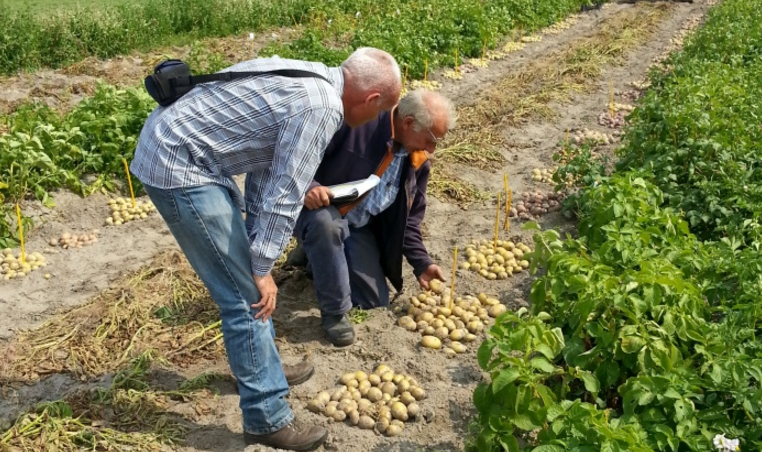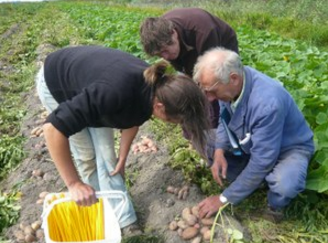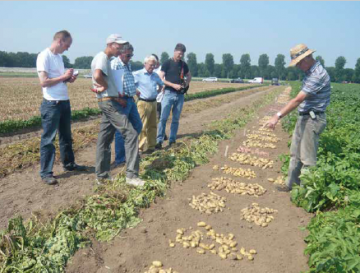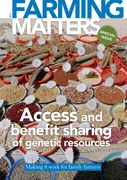The Dutch potato breeding model, which involves a partnership between farmers and commercial breeding companies in a modern, Western context, is unique. While there are other examples of collaborative relationships between farmers and breeders in Europe, the Dutch potato breeding model stands out in terms of its long track record, the involvement of the private sector, and the institutional integration of the relationship which up to today facilitates access to genetic materials and financial benefit sharing.

Photo: Louis Bolk Instituut
Dutch potato breeding model Participatory Plant Breeding (PPB) is considered to be particularly relevant to smallholder agriculture in developing countries. PPB involves getting farmers to participate in order to overcome shortcomings in the formal plant breeding system. The potato breeding system in the Netherlands has a long standing tradition of farmer participation in breeding and is often referred to as ‘the hobby breeder model’. The Dutch potato PPB is unique because of private sector involvement and its situation in a modern Western context. Potato breeding in the Netherlands is rooted in decades of breeding by family farmers in their own fields. When public and private sector breeders became increasingly involved, farmer-breeders continued to contribute significantly to developing this potato breeding system, which supplies a large diversity of crop varieties that are grown in very diverse environmental conditions around the world and for different consumer markets.
Farmers’ knowledge and skills are particularly well expressed and vital in breeding in potato which is a very heterogeneous and vegetatively propagated crop. In the Netherlands a new PPB initiative called BioImpuls emerged in 2010, which engages organic potato farmers in a search to develop late blight-resistant varieties for the organic sector. This example supports the argument that farmers’ knowledge can substantially contribute to modern and diversified breeding. While Dutch potato breeding is a special case in various respects, this article indentifies several key attributes which could inform the design of successful PPB programmes in developing countries.
The collaborative potato breeding model in the Netherlands is set in the context of a highly productive agricultural sector. Potatoes are grown by 45% of the Dutch arable farmers and cover more than 150,000 ha of Dutch agricultural land. Forty-six percent of this land is used to grow ware potatoes, 28% starch potatoes and 26% seed potatoes. With an average yield of 46.7 t/ha, Dutch potato yields are among the highest in the world. Approximately 70% of Dutch seed potato production is exported to be grown in diverse environmental conditions around the world and for different consumer markets.
Farmer participation in Dutch potato breeding
The effectiveness of farmer participation in the Dutch potato breeding model in the Netherlands is well illustrated by the share of farmer selected varieties grown there. In 2009, 409 potato varieties were planted for seed potato production. Of these 409 varieties, 293 (almost 75%) have been bred in the Netherlands. Half of those Dutch varieties have been selected by farmer breeders, covering 44% of the total area planted with seed potatoes (Fig. 1). Based on diverse sources of expert information we estimate that 82 farmer-breeders have contributed to this development. Many of the farmer bred varieties have become top varieties. One example is the Spunta variety, which was released in 1967 and still occupies the largest seed acreage (12%). A more recent example of a successful farmer bred variety is Sylvana, which was released on the market in 2008 and is rapidly gaining market share.
Mutual dependency and benefit

The partnership between the commercial breeding programmes and the farmer-breeders was and still is one of mutual dependency and benefit. For the breeding companies the experienced and eager eye of the farmer-breeders is irreplaceable. Their level of expert knowledge is evidenced by the number of varieties registered in the name of farmer-breeders.
Thus, the work of the farmer-breeders provides breeding companies with a high quality and diverse selection capacity at a relatively low cost that involves minimal investment in labour and land (as the farmers work on a no-product/no-pay basis).
Through farmers’ participation, the company breeders can handle many more crossings and seedlings without having to evaluate all of the seedlings themselves. This is particularly relevant for potato breeding, which is largely a matter of numbers because of the high level of genetic heterozygosity and the many varied agronomic and quality traits that potatoes can be selected for.
At the same time, most farmer-breeders do not want to get into the more complicated crossing activities and need the company-breeders for access to improved germplasms with novel characteristics and resistances. The introgression of resistance genes from wild species takes 15–20 years of extensive (back) crossing and selection, which can only be conducted by large commercial companies or by publicly funded breeding research programmes. To an extent, even the independent farmer-breeders depend on larger breeding programmes. The few independent farmer-breeders who still make their own crosses use existing commercial varieties as parental material and source of new genes.
Legal space for farmerbreeders
The use of existing commercial varieties as parental material by those Dutch potato farmer-breeders who make crosses themselves is allowed under the breeder’s exemption in the Breeders’ Rights Act (this exemption is now under pressure from the proposed TTIP free trade agreement between the EU and the US), which states that breeders cannot market protected varieties from other companies but are free to use each other’s varieties for commercial breeding purposes. The Dutch companybreeders and these independent farmer-breeders often know each other from events organised by the companies and the potato breeding associations, and usually describe their relationships as friendly and collegial. Company-breeders even share materials from their programme with some of these independent farmer-breeders. The reasoning is that regardless of whatever success an independent farmer-breeder may have, they will be lagging several years behind the breeders’ efforts anyway. This exchange of breeding materials shows how rivalry and collegiality go hand-in-hand in the Dutch potato breeding sector.
The financial/legal model

Initially, the farmer-breeders received public incentive payments, premiums and awards for successful breeding results. These later developed into royalty payments which are now linked to plant breeders’ rights. The financial arrangements between the associated farmer-breeders and breeding/trading companies is currently organised on a ‘no product/no pay’ basis. A farmer-breeder who receives seedlings from one of the companies usually signs a contract defining the sharing of ownership, the benefits, and the costs of registration if they select a variety that will eventually be registered and marketed. Depending on the way responsibilities are shared, the varieties are registered for breeders’ rights in the name of the farmer-breeder and/or the company responsible for trading and maintenance. The sharing of royalties for a marketed variety varies accordingly. Independent farmer-breeders tend to seek a private arrangement for the clone they offer with one of the trading companies. Since their role in the development of the variety is usually larger or even independent of a commercial breeding programme, their share of the royalties can be considerably more than 50%. They can also opt to be the sole owner and license a trading company to propagate and commercialise their variety.
Current developments
Three factors have contributed to the success of this unique collaboration model: the specific historical context of the Dutch agricultural sector in which public institutional support to private sector breeding stimulated the development of collaborative relationships, a high level of farmer-breeder expertise, and potatoes being a genetically diverse and usually vegetatively propagated crop.
The importance of the potato crop for national food security and export earnings stimulated the potato sector to join forces with Dutch research and government institutions. Different forms of collaboration go back to the early 20th century, but the establishment of the Commission to support breeding and Research of new Potato varieties (COA) in 1938 was a landmark event.
The COA played an important role in coordinating and supporting developing potato breeding systems in the Netherlands, trying to engage more farmer-breeders in potato selection work through extensive and free distribution of seeds, seedlings and clonal material, the provision of technical assistance, and incentive and premium payments.
Over the past decades, there has been a decrease in the number of farmer-breeders as the population ages. However, a renewed urgency to overcome the threat of potato late blight has recently swung the pendulum, triggering new and younger farmers, as well as companies, to become engaged in seed potato selection. This urgency was especially felt by Dutch organic farmers after the dramatic potato late blight incident in 2007. Between 2000 and 2007, 20% of the country’s organic potato growers stopped producing potatoes because there were no late blight resistant cultivars and no alternative fungicides for late blight are permitted in the Netherlands. Availability of disease free varieties became a key issue.
The future: spearheading development of new varieties
Even if the organic sector may have been previously considered too small to justify the development of specific varieties, the sector has taken the initiative to establish a Dutch PPB model through the publicprivate funded project BioImpuls. In this long term programme, six commercial companies, two public research institutes and an increasing number of organic farmer-breeders are collaborating to improve the access and availability of organic potatoes and potato seeds. The purpose of BioImpuls is twofold. First is to develop genitors with new late blight resistance genes from wild relatives, and the second is to support a larger number of organic farmer-breeders in joining the selection programme through offering training courses in selecting potato late blight resistant varieties which have attractive market characteristics such as satisfactory production, good taste, good skin and tuber shape.
Conny Almekinders (Conny.Almekinders@wur.nl) is a researcher at the Knowledge, Technology and Innovation department of Wageningen University, the Netherlands
Loes Mertens (loeskemertens@hotmail.com) is an organic plant breeder at Sementes Vivas, Portugal
Jan van Loon (janannyvanloon@hetnet.nl) is a Dutch independent breeder
Edith Lammerts van Bueren (e.lammerts@louisbolk.nl) is senior researcher at Louis Bolk Institute, the Netherlands
This article is based on Almekinders, C.J.M., L. Mertens, J. P. van Loon and E. T. Lammerts van Bueren (2014). Potato breeding in the Netherlands: a successful participatory model with collaboration between farmers and commercial breeders. Food security Volume 6 (4): 515-524. doi 10.1007/s12571-014-0369-x

